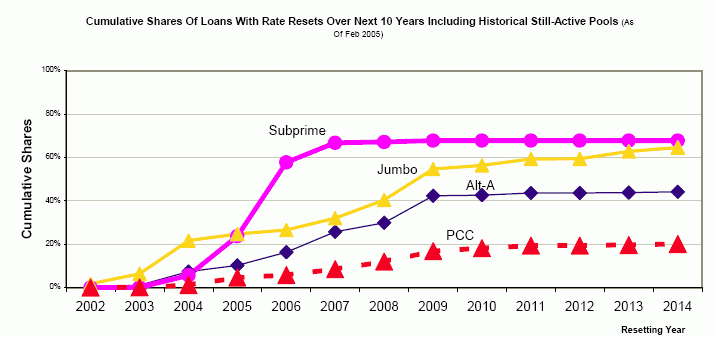
As you can see, 2006 and 2007 will be peak years in terms of subprime and jumbo loans. Given that many of these loans have prepayment penalties many folks will not be able to refinance given the limitation inherent in the loans. The reason we have not seen the impact of the current ARM resets is that the real estate market has been hot. So hot in fact that even with a prepayment penalty many were able to cash out or even sell homes before facing the piper. This circular system keeps working until appreciation stops. Not only that, rates are much higher than they were in 2004. Keep in mind that most ARMs and interest only loans are pegged to short-term rates such as the LIBOR. Basically they go in tandem with the feds short-term rates.
This is important because another argument you will hear is the fact that the 30 year rate is trending down. Now, this is another important issue to consider. Why would 70 percent of California use interest only, ARMs, or option only mortgagees this last year if rates were so attractive? Because they cannot afford the homes! This party is now over as is demonstrated by the massive decrease via our canary in the mine, San Diego:
http://www.signonsandiego.com/news/business/20061011-1231-bn11homes.html
The drop is 4.5 percent year over year and DOUBLE of the 2.2 percent loss we had in August of 2006. Leverage is a beautiful thing, like looking at a reddish sunset over the desert. When things are going good, you can get wealthy very quick. When things go down however, leverage works just as fast in the opposite direction. By looking at the above chart, we have yet to see what will happen when appreciation takes a quick exit on the 405 to depreciation, inventory numbers explode, and rate resets happen to many unsuspecting homeowners. I believe many of these homeowners assume they’ll be able to sell their home believing 20 percent year over year increase are cemented into the equation. Even if the market stays flat, where will they come up with the average 6 percent commission to market and sell the home? This question will be answered next year and hopefully it’ll only cost one ARM and no leg.
Filed in: mortgages housing-data

 Digg This!
Digg This! Add to Reddit!
Add to Reddit! Save to del.icio.us!
Save to del.icio.us!
2 Comments:
do you follow primarily the California housing market?
good info there, it makes me glad I got a 30 year! Out here (Boulder area) ARM rates are already worse than 30 years, or at least in our case. I never really put two and two together about the interest rate...if you need to get out of it after 5 or 7 years or what not, it's obviously easier to do when the market isn't crap like it is now (for us.) I imagine a lot of people are going to be "up in ARMS" and unable to get out of their mortgages. Does this mean an increase in foreclosures and eventuall enough of those to bring out the buyers again? I don't know, I'm just speculating. I'm sure there are about a million other factors going into it.
Thanks for the post Caroline. I mostly follow California, in particular Southern California, because that is where I have some expertise. However the first rule anyone learns about real estate is that prices are all about location, location, and location. Yet for the first time since the Great Depression we have seen median prices decrease year over year. And a question everyone should be asking is why would prices drop if we are supposedly in a booming economy? Hmmmm.
You are in great shape with a fixed rate. Colorado is a beautiful state and so is the Boulder area. I visited many years ago on a family trip and loved the city. But it does seem that there is speculation in Colorado as well. If anything, speculation has occurred in most metropolitan areas of the U.S. especially in coastal regions. Not sure how all of this goes but sure is interesting following the trend right?
Post a Comment